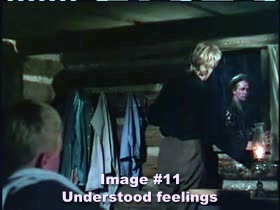THE American WESTERN
By Jeffrey-Baptiste Tarlofsky
By Jeffrey-Baptiste Tarlofsky
Lesson 18 consists of 7 video lectures and transcripts of those lectures, and 6 film excerpts. Start with the lecture, Part 1 and continue down the page in sequence until you reach the end of the lesson.
レッスン18は、7本のビデオレクチャー(レクチャーのテキストがビデオレクチャーの下に記載されています)と6本の動画で構成されています。
このレッスンは、最初のLecture Part 1から順番に動画を見たりテキストを読んでください。
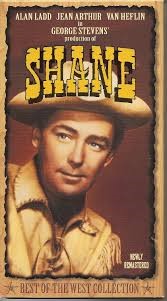
Directed & Produced by: George Stevens
Screenplay by: A.B. Guthrie Jr and Jack Sher
Based on: Shane 1949 novel by Jack Schaefer
Starring: Alan Ladd, Jean Arthur, Van Heflin, Brandon deWilde, Jack Palance
Music by: Victor Young
Cinematography: Loyal Griggs
Running time: 118 minutes
Part 1 – For the next four lectures, I will be discussing the film Shane (1953). One of the main reasons we studied The Left Handed Gun and The Gunfighter was to prepare us for Shane. Shane is unquestionably one of the greatest Westerns ever made and it is also consistently the film my Japanese students say they like the best in this course. There are many reasons students love this movie so much, but I think I won’t talk about them yet, but instead will let you fall in love with the movie yourselves in your own way.
But do let me place Shane in context for you. Shane, like Red River, is a film about true events in American history, though it is a highly fictionalized version of those events. Red River was about the first cattle drive along the Chisholm Trail. Shane is loosely based on The Johnson County Cattle Wars. The first cattle drive on the Chisholm trail took place in 1865, the Johnson County War took place from 1889-1893. In other words, these two stories occur at the beginning and the end of the twenty-five-year period I have identified as the peak years of Western settlement, (1865-1890). Both historical events are also centered on the cattle business and the beginning of Red River and all of Shane is about who controls the land on which the cattle graze. As you read for your homework, there are still violent confrontations in the American west over how land should be used. Americans are still shooting each other over some of the same issues the characters in our movies fought over.
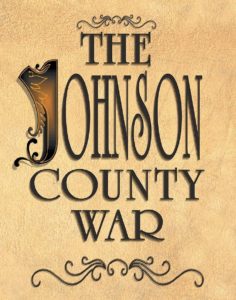
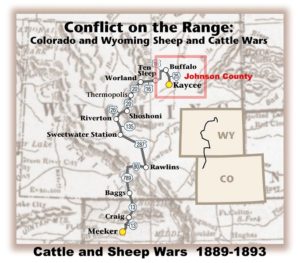
In Red River, Thomas Dunson tells Don Diego’s guard that he is taking control of all the land north of the Rio Grande for about four hundred miles. He is claiming about as much land as there is in Chiba Prefecture! In other words, it will be impossible for him to guard it all or use it all. The truth is that Thomas Dunson could not legally claim that much land for his own, but he could insist that the land was “open range”, meaning no one else, (Don Diego for example), could tell him he could not graze his cattle there. “Open range” meant that anyone could graze a herd on the land. In the vast American West, some 53% of the land today is still designated as rangeland and much of that is managed as “open range” by the United States government. The cattle from different ranches would all graze on the open range and the only way ranchers knew which were theirs was by the brand.
Up through the 1860s and even the early 1870s, land and water were still so plentiful there was not much need to fight over it. But as more ranchers went into business and sheepherders started their herds and farmers began to settle the land, the struggle for control of the range turned violent. You read that the cattle ranchers virtually destroyed the sheepherders through violence. You remember from The Left Handed Gun that the English cattleman, John Tunstall, was a small rancher murdered by more powerful big ranchers. In the film Shane, the conflict is between the cattle ranchers and homesteading farmers.
Part 2 – The first thing we notice about the film is that Shane, unlike Stagecoach, Red River, Wagon Master, The Left Handed Gun, or The Gunfighter is filmed in color. In fact, it was one of the very first films to use a new simplified color process by Technicolor. Color films were still expensive and relatively rare in the early 1950s. The first color films had been black and white films that were hand-painted with tiny paintbrushes in a process that took hundreds of hours for just minutes of colorized film. It was not until 1935 that a film was actually filmed with color stock film. In addition to using color, Shane was also the very first film in which Paramount studios used a new widescreen system which greatly expanded the aspect ratio from 1.37:1 to a much wider 1.66:1. This means that the screen was much wider than any we have seen before in any of our other films. The studio built a new movie screen for the premier of Shane in New York City’s Radio City Music Hall replacing the old 35X25-foot screen with a much larger and much wider 50x 30-foot screen. In other words, if you were lucky enough to see the premier of Shane in 1953 you were seeing a bigger, wider, and more colorful western than anyone had ever seen before. Shane was something quite new in visual terms.
It is a genuine shame that I cannot show you this film on a large screen. Some of you are watching it on your phones. This means you are missing the sense of grandeur the film had. At least you can still appreciate the color, though. Does the use of color and widescreen mean that Shane is cinematographically superior to a film like John Ford’s Stagecoach? Indeed, no. It still depends on what the director and his cinematographer do with their film stock and what they show on the screen that matters. I am certain George Stevens would have been very flattered to be compared to John Ford, however. But, as we say in English, “you cannot compare apples and oranges”. Color and black and white films do different things. But, while they do cinematographically different things, we can still point out some similarities between George Steven’s Shane and the other films. Just as John Ford did in Stagecoach and Howard Hawks did to a lesser extent in Red River, Steven’s gives us a sense of the vastness and emptiness of the American west in Shane. One of the first things I learned when I studied Chinese and Japanese landscape painting was how these paintings show humans dwarfed by nature. The painters remind us that we are relatively insignificant in the natural world. (Image #1). Doesn’t Stevens accomplish the same thing in this shot? The rider is just a tiny speck in this vast landscape. The use of the wider aspect ratio greatly helped Stevens to depict the vastness of nature.
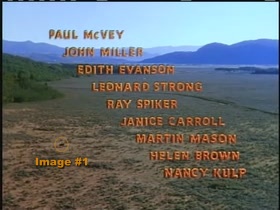
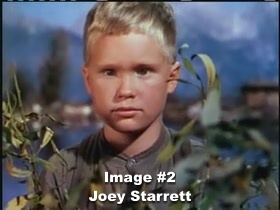
On the other hand, we can contrast Shane with our other films by noting that Steven’s use of color seems to bring out the “freshness” of the valley into which this lone figure rides. The mountains are lush and green, the sky enormous and blue, the mountains towering majestic and purple. The colors help us appreciate not just the visual beauty of nature but it also activates our other senses. We can practically breathe in the freshness of the air as we descend into the valley.
As we enter that valley, we gain a perspective, a pair of eyes through which we will see the entire story. Steven’s has us view the arrival of the newcomer through the eyes of eight-year-old Joey. (Image #2). It was purely by luck that Steven’s happens to have filmed the deer’s antlers framing the approaching Shane (Image #3 below). But this was a film which seemed to have plenty of good luck following it. Steven’s originally wanted Shane to be played by Montgomery Clift (Matt from Red River) and Joe Starrett to be played by William Holden. Both were superb actors, but neither would have been half as good as the actors he eventually ended up with, Alan Ladd and Van Heflin. Along with the rest of the cast, they would create characters who were not only absolutely convincing, but who would form as tight a company as any John Ford would ever work with after using the same actors in many films.
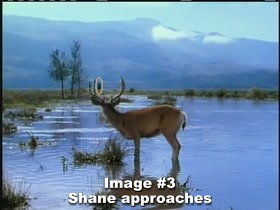
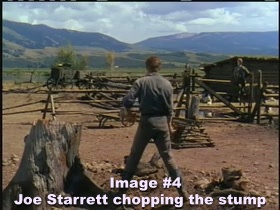
Joey is our witness in Shane just as Groot was the narrator in the better version of Red River. I should explain this. There are two versions of Red River, one in which the story is told in writing from what might be a diary (but written by whom we don’t really know. Certainly not by Groot since he cannot read or write). This is the only version of the film which has Japanese sub-titles and so it is the version I use in our class. But the better version has Groot telling the story as it unfolds With Groot as our narrator, we feel closer to the events as they happen and we also feel his growing anxiety as the events in the film unfold. In Shane, with Joey as our witness to all the key events, (except one), we also feel what he feels. I will say more about this later.
In Red River, I told you to “keep your eyes on that bracelet” throughout the film. In Shane I am going to tell you to keep your eyes on that tree stump Joe Starret is chopping at with an ax as Shane approaches the homestead. (Image # 4)
Steven’s shows us Shane as Joey sees him, in a shot that is almost portrait-like and heroic (Image #5 below). Joey, instantly recognizes that Shane is something special and different. Remember that in the old west little boys didn’t have sports heroes or music idols to look up to. The most famous men of the old west were gunfighters like Johnny Ringo. Joey’s suspicions about what Shane is are confirmed when the little boy casually racks his rifle only to have Shane instantly whirl on him and almost draw his gun. Joey’s father somewhat nervously observes that Shane is “a little touchy”. But Joey asks, “I’ll bet you can shoot, can’t you?” As if on cue (which it was) as Shane answers this question with a modest, “A little” we hear the change in the music and the distant whoops of the approaching Riker brothers with their cowboys. Mr. Starrett, assuming Shane is an advance scout for their party, suddenly becomes cold, reaches of Joey’s rifle, and firmly asks Shane to leave his property. But Shane gently asks him to lower his gun so he can leave peacefully.
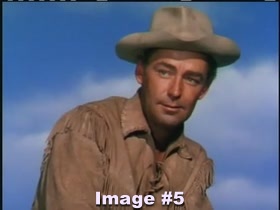
Part 3 – In barely two minutes the entire conflict in Shane becomes completely clear to us. Riker is a rancher who claims that all the land in the valley is open range and therefor available for him to graze his cattle on while Mr. Starrett claims his rights under the Homestead act of 1862, which provided that any adult citizen, or intended citizen, who had never borne arms against the U.S. government could claim 160 acres of surveyed government land. Claimants were required to “improve” the plot by building a dwelling and cultivating the land. Starrett has clearly done both. They are having a dispute over whose interpretation of the law is correct. But Riker isn’t one to settle an argument with mere words and warns Starrett that he could “blast you out right now”. But Starrett bravely stands his ground and stubbornly tells Riker there are also laws against “blasting” people off their land. (Image #6)
It isn’t Mr. Starrett’s stubborn courage that pulls the Rikers up, however. It is the sudden appearance of Shane from around the corner of the house (Image #7) that changes things. The younger Riker brother, Morgan, asks “Who are you, stranger?” and Shane makes it clear which side he is on by saying “I’m a friend of Starrett’s”. Why should that make any difference? After all, there are six armed men in Riker’s group and Shane is only one man…just standing there. He isn’t even standing up straight, he is sort of leaning in a relaxed way against the side of the house. But no normal man would be relaxed in this situation. Shane has not told them his name, but he is letting them know what he is. It was obvious enough that Joey figured it out almost immediately and the Rikers and their men certainly have a good idea of what he is as well. It is no accident that Stevens decided to show the Rikers with six men. That is exactly how many bullets Shane has in his gun.
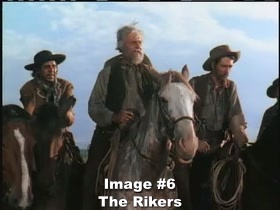
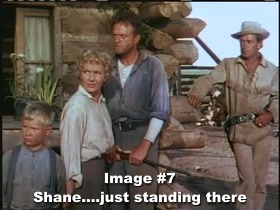
Oh, come on! Nobody is that fast! Remember what I said about a gunfight? Gunfighters win or lose a fight before they ever reach for their gun because a gunfight is a test of will. Shane has already won this fight simply by showing the six men he is completely unafraid of them. These cowboys all know that a gunfighter could easily outgun any one of them and probably two of them as well. A good gunfighter might even kill three men and live to walk away. What did this man say his name was again? He didn’t say. What if this were someone like Johnny Ringo, or Wyatt Earp or the fictional William Munny (this is a movie, after all). Someone like that…he might just kill all six and live to tell the story. Four of these men are just cowboys earning a dollar a day working for the Riker brothers. They may think it is good fun scaring a farmer, his wife, and their little boy, but facing a gunfighter is another story. And this gunfighter is just standing there not even taking a fighting stance. The confrontation ends with more threats from Riker, but he and his men retreat.
Part 4 – Friendship. One simple act of kindness follows another. Shane helped Starret face down the Rikers, Starret invites Shane to dinner. This is the simple hospitality which is the mark of good people throughout the world. I have eaten dog stew with the Lakota Indians in North Dakota, sat down to meals of pig’s intestines and homemade beer with the K’hoh people in the mountains of Vietnam, enjoyed what I hope was a “chicken dinner” with the notoriously cannibalistic Batak tribe of Northern Sumatra and partaken of gazelle and impala while on safari in Botswana.
In all these cases, the sharing of food made for good relations and sometimes good friendships. Mrs. Starret is using her good plates and a second fork for their guest. The hunks of delicious-looking pie she serves the men (and the little boy!) are enormous. (Image #8) Hard-working men (and little boys!) have big appetites. It is a generous family meal and Shane is treated as an honored guest. Shane, always well-mannered and soft-spoken, tells Mrs. Starrett her dinner was “elegant”. Throughout the film, Shane speaks in a way that makes him sound like he is better educated than the average cowboy or gunfighter. The other thing about the way he speaks is that he has no discernible accent of any kind. It is impossible to say where he comes from. Shane is a mystery.
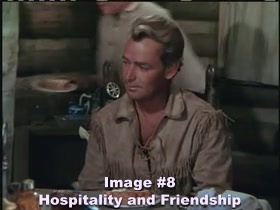
To show his gratitude for the “elegant dinner” Shane goes to work on the tree stump Mr. Starrett had been chopping. Mr. Starret soon joins him and the men work together into the night. The music soars at this point in a way I find reminiscent of Aaron Copeland’s Ode to The Common Man.
The composer for Shane was the extremely talented Victor Young who was born in Chicago but was sent to Poland for his musical education and remained there throughout his early years. When he finally returned to America, he was a thoroughly European composer…like Richard Hageman of Stagecoach and Dmitry Tiomkin of Red River! Unlike Hageman and Tiomkin, Young did not specialize in music for Westerns. He worked on any kind of film and holds the record for most Oscar nominations for best musical score by any composer (twenty-two!). Unlike the scores for Stagecoach and Red River, Young’s score for Shane does not just set out the general feeling and atmosphere of the film. Young’s score adds emotional value to specific moments in the film and becomes associated with specific characters or types of actions in the film. It is a much more complex score than either Hageman’s or Tiomkin’s. We have already heard the music become “sinister” as the Rikers approached the Starret farm. Now we hear it soar into nobility as the two men solidify their friendship through their hard work.
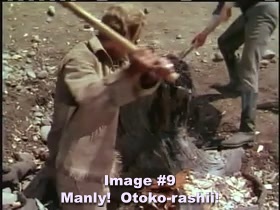
Mrs. Starrett, being a sensible woman, suggests her husband use the horses to pull the stump out, but Mr. Starret tells her that he and Shane have to beat the stump with their muscles because they are men (Otoko!). There is something charming and innocent about admitting that sometimes men just have to use their muscles instead of their brains. I completely understand this. For many years (until I injured myself), I heated my house with firewood I partially cut and stacked myself. I love being outside chopping the wood on a cold day and then heating the house with wood from my own woodpile. Very “Otoko-rashii”!
But I told you to keep your eyes on that tree stump, remember! As the film goes forward, please remember to think about it and what it might symbolize. I am afraid we can’t use our muscles to solve that mystery. We will have to use our brains. (Image #9)
Part 5 – So Shane decides to stay in the valley and go to work for Mr. Starret. This is something I want you to think about for your homework. Why does Shane stay in the valley? Also, Joey asks his father why Shane didn’t wear his gun when he went into town. Shane has taken off his gun. Also, think about what this means.
CORRECTION; PART 6 OF THE VIDEO LECTURE FOLLOWS AFTER
Part 6 – The big cowboy, Chris Calloway, was played by none other than Ben Johnson, one of John Ford’s stock company and the co-star of Wagon Master along with Harry Carey Jr. In Shane, he takes on the role of a bad guy and a bully and does so very convincingly. Calloway was not one of the cowboys who saw Shane at the Starrett farm the day before. He only sees Shane dressed as a farmer after Shane takes off his buckskins and silver gun belt. If he had seen Shane dressed that way and wearing his gun, he might have been much more careful how he talked to him. But Calloway believes Shane is just another farmer he can buffalo (intimidate) easily and Shane, for reasons of his own, chooses to walk away from a fight with him. (Image #10)
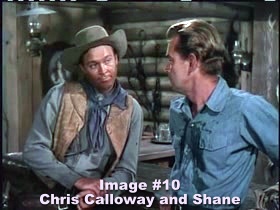
Part 7 – As Shane stands in the rain Joey says that he knows Shane isn’t afraid. Shane simply says “it’s a long story” and Mrs. Starrett’s answer is to say, “I think we know”. (Image #11) Maybe one reason my Japanese students love this film so much is that the people in the film communicate in a very Japanese way. What do I mean by this? Americans are famous for being “plain spoken” and direct in their talk, but in the Wild West, there was also the belief that people should not talk too much. This idea is quite similar to the old Japanese expression “silence is golden”. It is the belief that you should only say something if you have something important to say.
But the truth is that Japanese leave many important things “unsaid” because they are already understood. The most famous example of this is how very rare it is for people who are in love to say “I love you” in Japan. In Japan, if two people are really in love, this should not need to be said, it is understood. Important things are left unsaid in Shane even though they are understood. Mrs. Starrett says she understands Shane’s “long story” even though she has not heard him tell it. She has a strong intuition.
She also tells Joey not to become too attached to Shane because he will be going away one day and he’ll be upset. This time she does say what she is thinking. We will have to wait and see if her intuition here is correct.
